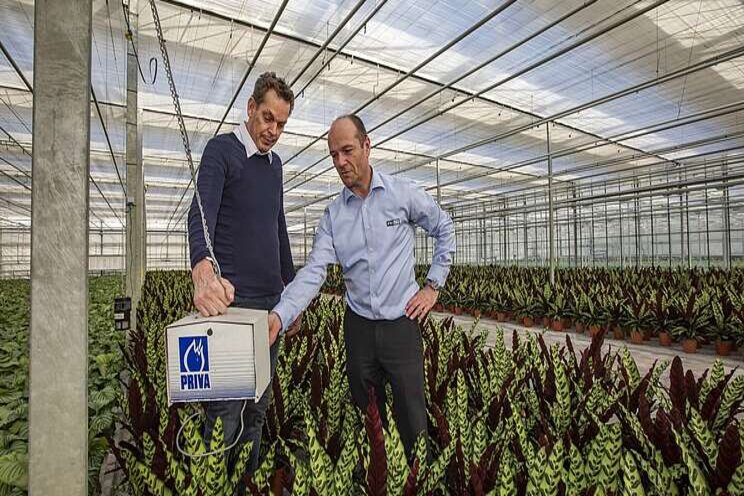Priva Connext has smart new functions
Added on 09 March 2020

Calathea grower Teun Valstar has implemented a new process computer
"It is incredible to think of the developments that horticulture has gone through," says Valstar, who over the years has expanded his own company into a hyper-modern 4-hectare nursery. "I can still clearly remember that 34 years ago we had to open the ventilation windows by hand."
Valstar has used Priva computers since he founded his nursery more than three decades ago. Priva consultant Hein Jasperse emphasizes the important role made by process computers during the development of the horticultural sector: "Controls have become increasingly intelligent and they increasingly ensure optimal growing conditions for the crop with minimum use of water, energy and nutrients."
More stable and accurate
Valstar's first experiences with the Priva Connext are certainly positive. "It's even more stable than the Intégro and the buffer filling is more accurate, for example. And there are many new features that I haven't even used yet so soon after installation."
Valstar's feedback sounds familiar to Jasperse, who regularly notices that growers don't always get the most out of Connext in their day-to-day work. "So much is possible. That's why it's very useful to follow some training."
Smart chinks in screen
According to Jasperse, there are several commonly used new controls that could come in very handy at Valstar's nursery. One of them makes it possible to regulate the chinks in the screen based on relative humidity (RH). Jasperse: "The biggest disadvantage of chinks is that they lead to an unsteady regulation with the screen going back and forth a lot. When the RH becomes too high, a gap opens up which becomes larger as the RH increases further. This gap not only reduces the RH but also leads to a drop in temperature, which causes the heating pipe temperature to rise; the gap then becomes smaller and the RH rises again. This ultimately leads to an instable greenhouse temperature, pipe temperature and RH."
Jasperse explains that the improved scheme for controlling the chinks in the screen uses the 'step' method. It takes very small steps with a delay in between so that the drier air has time to mix. "If you set moisture or temperature as the set point for the chink, for example at 80% or 22 °C, the corresponding absolute humidity (AH) becomes the tipping point. Above this value, the screen will be directed to open; below this value the screen will always be directed to close. This is therefore clearly different to the previous method of controlling the chinks and it results in a very stable temperature and air humidity."
Less wire breakage
Valstar is impressed by this approach to managing the chinks. "Coincidentally, in one of our greenhouses where there is a diaphragm screen, we suffer from wire breakage and wear and tear because the screen opens and closes so much. I think this new control could help me to prevent that in future. Moreover, the plant does not suddenly receive too much cold air at the top. You want to avoid that at all costs, especially when the temperature is close to the condensation point."
Valstar recently added a new greenhouse, and that is always a time to be extra alert according to Jasperse: "The climate in a new greenhouse often behaves slightly differently due to a different height or light permeability, for example, or perhaps a new screen cloth. You'll find that factors create a slightly different dynamic, so it's important to pay extra attention to the settings."
PAR-control
The correct lighting is crucial for the growth and quality of the crop. With that in mind, Jasperse explains the PAR control to the calathea grower. The PAR control continuously monitors the lighting and regulation of the screens and automatically makes adjustments for optimal results. "This is a good system, especially when using two screens in which the lower cloth has to scatter the light. Suppose the upper screen is set to close as soon as the radiation exceeds 200 W/m˛. Then the PAR control can maintain the desired PAR level by ensuring that the lower screen opens or closes as evenly as possible, without it constantly moving back and forth. You only have to set it once," says Jasperse.
He then points out the convenience of working with a start-series for watering. This makes it possible to link a number of water valves to a group and then set up a series of up to 10 starts per group. These can correspond to constantly changing recipes or watering periods, and it is also possible to set the conditions per watering. Valstar is already using this function: "It's very good, especially if you'll be away from the nursery for a few days."
24-hour temperature control
Valstar is also pleased with the control for the day-night temperature, which continuously monitors the temperature and automatically adjusts the ventilation and heating for optimal results. "This system allows you to accurately achieve your desired average temperature to a tenth of a degree over a 24-hour period, so you can easily influence the growth rate of the crop. That's terrific."
Lastly, Priva consultant Jasperse highlights the handy overview screens behind each tab on the process computer. "These screens show you why the system is doing something and give the reason for a possible malfunction. That saves a lot of guesswork!"
Source: Goedemorgen
More news















